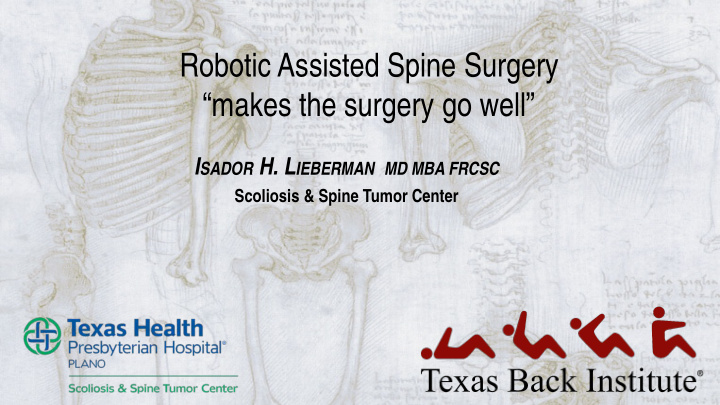



Robotic Assisted Spine Surgery “makes the surgery go well” I SADOR H. L IEBERMAN MD MBA FRCSC Scoliosis & Spine Tumor Center
I SADOR L IEBERMAN MD MBA FRCSC disclosures October 2017 Research Stock Consultant Royalties Support Options Mazor Robotics X X X X X Stryker Spine X Globus Misonix X X Safe Orthopaedics Medtronic X X SI Bone AAOS; member CME Courses committee ISASS; member Public Policy committee SMISS; member Board of Directors Editorial board; Spine, JSD&T, European Spine J
Spine Surgery is all about Control,,,
Spine Surgery “we measure with a micrometer, but cut with a chain saw,,,”
Robotic Spine Surgery “ to boldly go where no spine surgeon has gone before”
Robotic Spine Surgery “ to boldly go where no spine surgeon has gone before”
Surgical Robots • Passive, Semi-active or Active modes – Positioning surgical tools – Perform surgical procedure – Mimic surgeon’s actions
Pre-op Planning
Pre-op Planning
Multiple Technologies Available & In Development
Robotic studies Lieberman et al, Assessment of Pedicle Screw Placement Accuracy, Procedure Time, and Radiation Exposure Using a Miniature Robotic Guidance System. J Spinal Disord Tech . July, 2012 • Cadaveric study, 14 surgeons • 50 times more radiation with freehand • most readings for the robotic guidance users were below measurable levels • Procedure is not lengthened with the robot • Quick learning curve “pedicle screw placement accuracy was not dependent on surgeon experience.”
Robotic studies Kantelhardt et al, Perioperative course and accuracy of screw positioning in conventional, open robotic-guided and percutaneous robotic-guided, pedicle screw placement. Eur Spine J. 2011 Jun;20(6):860-8. • 57 free hand cases vs 55 robotic assist cases (20 – open, 35 percutaneous) • Robotic assistance significantly improved: • Implant accuracy, X-ray dosage, Complication rate • Re-operations, Average length of stay, Post-op opioids “In robot-assisted procedures the rate of misplaced screws and duration of intraoperative x-ray exposure were significantly lower, while procedure times did not differ significantly”
Robotic studies Devito et al, Clinical acceptance and accuracy assessment of spinal implants guided with SpineAssist surgical robot: retrospective study. Spine (Phila Pa 1976). 2010 Nov 15;35(24):2109-15. • 840 cases in 14 hospitals • 3271 pedicle screws inserted in 635 cases, assessed by intraoperative fluoroscopy, where placement accuracy of 646 pedicle screws inserted in 139 patients was measured using postoperative CT scans. • 49% of cases were percutaneous • 98% clinically accepted screw placement “Robotic Assist offers enhanced performance in spinal surgery when compared to free hand surgeries, by increasing placement accuracy and reducing neurological risks”
Robotic-assisted screw placement was successfully accomplished with less than 1% of screws malpositioned The use of robotic guidance in deformity and revision spine surgery appears to be better than the historical figures (reported malposition rate range from 4.2% to 15.7% )
The rate of successful and accurately placed pedicle improved with increasing experience, 30 cases to reach consistency The rate of the screws that were converted to manual placement decreased with increasing experience, better pre-op planning With robotic assistance, the screw malposition rates ranged from 1.4% early to 0% later with an overall malposition rate of 0.7%.
35 S2AI screws in 18 patients, No intra-operative complications that related to the placement, All trajectories were accurate, no violations of the iliac cortex or breaches of the anterior sacrum, at the entry point, At entry point the screw deviated from the pre-operative plan by 3.0±2.2 mm in the axial plane and 1.8±1.6 mm in the lateral plane, At the 30 mm depth, the screw deviated from the pre-operative plan by 2.1±1.3 mm in the axial plane and 1.2±1.1 mm in the lateral plane.
Surgical Outcomes of Robotic Guidance vs Freehand Instrumentation; A review of 705 patients Cannestra et al; SMISS Oct 2016, NASS Oct 2017 • Methods; 4 surgeons, Robotic guidance (n = 403), vs Fluoro guidance (n = 224) vs Freehand open (n = 78) • Results; complications = Robotic guidance 4.0%, Fluoro guidance 5.4%, Freehand open 12.8% revision rate = Robotic guidance 3.8%, Fluoro guidance 3.8%, Freehand open 7.7% • Conclusions; robotic guidance decreases complications and revisions
Interesting case • 44 yo F • Low back pain, occasional bilateral lower extremity numbness which has been present for about 1 year • She states that walking or sitting for long periods of time exacerbates her back pain. • She has had prior lumbar injections and physical therapy with limited relief. • h/o rheumatoid arthritis and is on steroids as well as methotrexate. • BMI: 36.78
Robotic Advantages • Minimize intra-operative radiation exposure • Improve Screw Placement Precision, Screw Pullout Resistance & Deformity Correction • Pre-operative Plan aids in recognition of subtle anatomic variants • Facilitate Less Invasive Exposures • Enhance Operative Efficiency
Robotic Assistance will not make a Bad Surgeon good,,, It will make a Good Surgeon Better! Lieberman 2010
Thank You
Recommend
More recommend